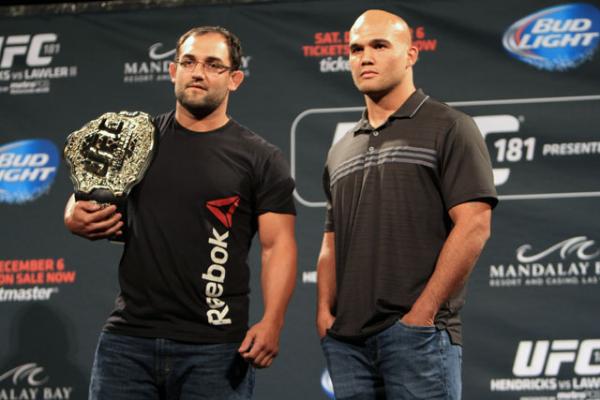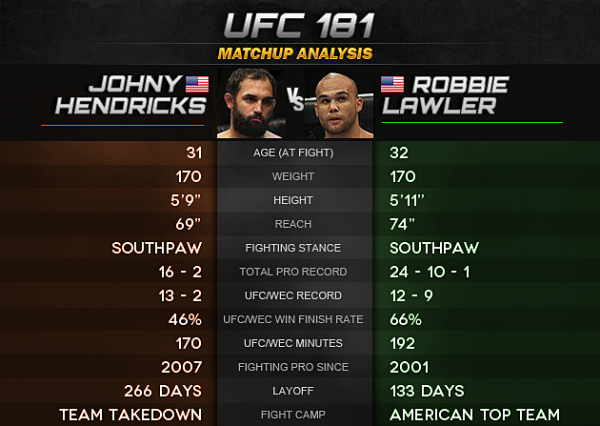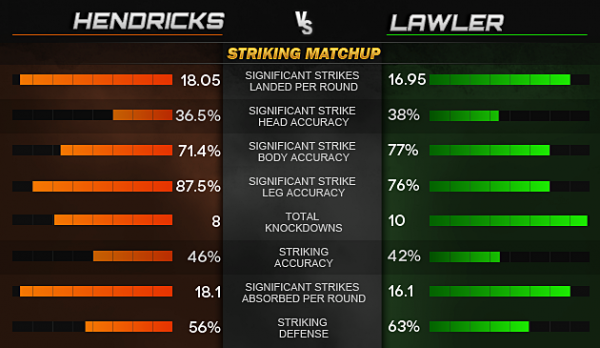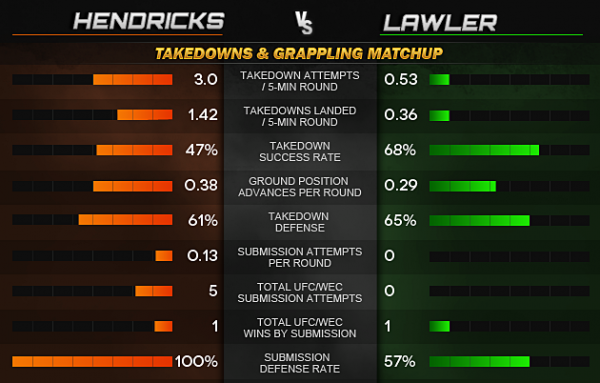UFC 181 Statistical Matchup Analysis: Hendricks vs. Lawler 2

Johny Hendricks and Robbie Lawler will meet for a second time. |
Photo: Jeff Sherwood/Sherdog.com
The Ultimate Fighting Championship is pulling out all the stops with UFC 181, its final pay-per-view event of 2014. On top of a card stacked with established names and exciting prospects, the headliner revisits one of the year’s best fights in a welterweight championship tilt between Johny Hendricks and Robbie Lawler. This is the first appearance for “Bigg Rigg” since their first fight, as he underwent surgery on a torn biceps in the aftermath of UFC 171. Meanwhile, Lawler has been busy dispatching other contenders, fighting twice in the months following his championship loss.
The first fight was an epic, back-and-forth brawl, and even though this is just the second welterweight championship fight in eight years that does not involve George St. Pierre, there are not many people complaining about it being a rematch. Does Hendricks have an advantage defending the throne for the first time or does fortune favor the career turnaround of Lawler?
Advertisement
Related: UFC 181 Preview
Let us see what the tape tells:

The Tale of the Tape favors Lawler’s anthropometrics. His five-inch reach advantage is a crucial aspect in his chances to win; the most successful moments he had in the first fight came when he imposed his striking at range. Another key difference here is the experience gap. Lawler has been fighting under the brightest lights in the sport for much longer, and it is easy to forget that these men are only a year apart in age. To put it in perspective, by the time Hendricks made his UFC debut, Lawler had already fought in several major MMA organizations, including a 4-3 stint inside the Octagon. Only time will tell if that experience -- some might see it as extra mileage -- leads to Lawler being wilier or slows him down. Nevertheless, Hendricks is experienced in his own right, having been groomed in the big leagues since his fourth professional fight.
The next difference of note is the finish rate. Both men have contributed spectacular finishes to the UFC archives, though Lawler tends to put away his opponents more frequently. Hendricks has scary power in his hands, and with a sturdy chin thus far, he has been able to mix it up with reckless abandon -- an ability that can turn the tide of a fight at any moment. The only other potentially significant factor here is the layoff: Lawler keeping busy immediately after the loss to “Bigg Rigg” is a good sign for him, since it shows that Hendricks inflicted little meaningful damage. On the other hand, Hendricks allegedly came into the first fight with the biceps injury, meaning his original performance could have been a diluted glimpse at what he is truly capable of doing.
Moving on, let us take a look at the striking numbers:

The vast majority of the first Hendricks-Lawler fight took place in the upright position, so we can expect to see a lot of standup action in the rematch. Hendricks maintains a busier pace on the feet, which would result predictably in a slightly lowered accuracy rate if it was not buoyed by his high-percentage leg strikes. That diversity in attack helped push Hendricks over the precipice at UFC 171. Over the course of his career, “Bigg Rigg” has utilized a more varied standup game, with 83 percent of his attempts being head strikes, six percent going to the body and 11 percent to the legs. By comparison, Lawler goes upstairs 89 percent of the time, with body strikes taking up the remaining 11 percent of strikes. In other words, Hendricks throws more diverse strikes in a more balanced manner.
Likewise, Lawler’s standup is slightly more lopsided when it comes to where he likes to throw his strikes from. For every 10 strike attempts, “Ruthless” is at distance for roughly eight of them, with the remainder split between the clinch and ground. Hendricks has fewer strikes on the ground -- which is surprising given his wrestling pedigree -- and instead favors the clinch for 21 percent of his strikes while being at distance 73 percent of the time. Hendricks used this balanced attack to gain an edge in the first fight: Even though Lawler landed 30 more blows to the head, Hendricks ended the fight with more total significant strikes.
When it comes to fight-ending shots, both men have one-punch knockout power. Half of Hendricks’ wins have come by way of knockout, and in substantially fewer fights, he only has two fewer knockdowns. Lawler, on the other hand, has notched 19 of his 24 wins by knockout or technical knockout, meaning he has more KO/TKOs than Hendricks has total fights. Though both have power, it is historically unlikely that either of them will be knocked out. It has yet to happen to Hendricks, and the only time Lawler was knocked out was 10 years ago against Nick Diaz in a fight as emblematic of “getting caught” as any. Neither champion nor challenger can be too comfortable, though, as both have the capacity to end the fight instantaneously.
The ground matchup offers a little more clarity in terms of who has the advantage:

Hendricks was a four-time NCAA All-American wrestler and two-time national champion at Oklahoma State University; naturally, the numbers indicate his superiority in related areas. He shoots for takedowns more often and hits at least one a round. When he gets to the ground, Hendricks is slightly more active in advancing position and going for submissions, but only by a negligible margin; he averages 0.13 advances per takedown, obliging seven or eight completions before he moves into a better position. Meanwhile, Lawler is more content to ground-and-pound. The American Top Team product has never even attempted a submission in a major promotion, and his only submission win came in a King of the Cage match in 2005. Similarly, Hendricks is not exactly a submission ace, failing on all five of his attempts in the UFC.
Furthermore, Hendricks has been immune to submissions, whereas Lawler has been forced to tap four times in a total of seven opponent attempts. Each of his submission losses came on his opponent’s first attempt. However, “Bigg Rigg” does not have the submission savvy of a Jake Shields or Ronaldo Souza, either.
Overall, the grappling matchup favors Hendricks, but if the rematch resembles the first fight at all, the only aspect that will matter will be his takedowns against Lawler’s takedown defense. At the same time, Hendricks’ takedowns add to his already more dynamic striking arsenal, which will likely play a large role in how the fight progresses on the feet.
THE FINAL WORD
The betting line has Hendricks as the -220 favorite compared to Lawler’s +180 underdog status, giving the Team Takedown representative an implied win probability of about 69 percent. This is rightfully one of the closest betting lines in recent memory. The first fight was up for grabs entering the fifth round, and even that frame was hotly contested for the better part of five minutes. The intrigue here is how the fighters will approach their game plans, the onus of adjustment falling more heavily on Lawler since he lost the first fight and is working with fewer tools overall.The numbers are helpful, but as a wise man once said, fate knows what probability does not, and this is a close fight as is. Precedent falls in favor of Hendricks, as champions have a 4-2 advantage when their first title defense is a rematch with the fighter against whom they won the belt. Can Hendricks finish the year as champion or has Lawler built enough momentum to pull off the upset?
Data for the analysis was provided by FightMetric. Eric Stinton performed all analysis. Stinton and Sherdog.com assume no responsibility for bets placed on fights, financial or otherwise.
Related Articles






